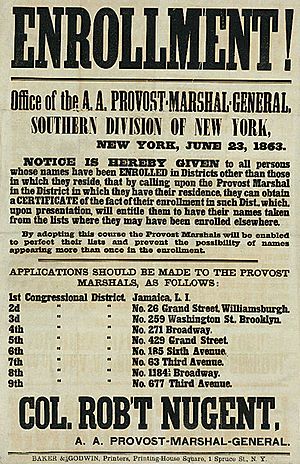Enrollment Act facts for kids
 |
|
| Long title | An Act for enrolling and calling out the national Forces, and for other Purposes |
|---|---|
| Nicknames | Civil War Military Draft Act |
| Enacted by | the 37th United States Congress |
| Effective | March 3, 1863 |
| Citations | |
| Statutes at Large | 12 Stat. 731 |
| Legislative history | |
|
|
| Major amendments | |
The Enrollment Act of 1863 was an important law passed during the American Civil War. It was also known as the Civil War Military Draft Act. This law was created by the United States Congress to get more soldiers for the Union Army.
Before this act, the army mostly relied on volunteers. But as the war continued, more soldiers were needed. This act was the first real national draft law in the United States. It said that almost every male citizen and immigrant who wanted to become a citizen, between the ages of 20 and 45, had to sign up for military service. Some people were excused, but most had to register.
The Enrollment Act set up a system to find and draft men. Each state and even each local area had a goal for how many soldiers they needed. If not enough people volunteered, then men would be drafted to fill the empty spots.
In some cities, like New York City, people were very upset about this law. This anger led to big protests and even riots, like the New York City draft riots in July 1863.
Contents
How the Draft Was Organized
To manage the new draft law, a special office called the Provost Marshal General was created again. James Barnet Fry was put in charge of this office. He reported directly to Secretary of War Edwin Stanton.
Under Fry, there were State Acting Assistant Provost Marshal Generals. These people helped manage the draft in each state. Some larger states, like New York and Pennsylvania, had more than one. Each state was then divided into smaller areas, and each area had an enrollment board.
Each enrollment board had a district provost marshal, a surgeon, and a commissioner. They also hired clerks and other helpers. These boards divided their areas into even smaller sections, like city wards or rural townships. In each small section, an enrollment officer took a census. This census counted every man who could be drafted.
Why People Criticized the Act
The Enrollment Act had some rules that made many people angry. Two of the most controversial rules were "substitution" and "commutation." These rules allowed drafted citizens to avoid serving in the army. They could either find someone else to take their place or pay a fee.
These rules were meant to help people who didn't believe in fighting or wealthy people. However, they made many ordinary citizens feel that the draft was unfair. People often said it was a "rich man's war, poor man's fight." This meant that rich people could avoid fighting, while poor people had no choice.
What Was Substitution?
Substitution meant that if you were drafted, you could pay someone else to serve in the army instead of you. This was allowed throughout the war.
However, there was a big problem with substitution. Some people who were paid to be substitutes would join the army, collect their money, and then run away before their unit went to the front lines. They would then do it again for someone else. These people were sometimes called "jumpers." Army leaders knew about this problem. Also, the soldiers who joined as substitutes were often seen as less reliable than regular volunteers.
What Was Commutation?
Commutation meant that if you were drafted, you could pay $300 to avoid serving. In 1863, $300 was a lot of money, like $5,000 for an unskilled worker today. This rule was created to keep the price of substitutes from getting too high. If there was no commutation, people might have paid even more for substitutes.
Commutation also helped raise money for the war. But many people criticized it because it seemed better at raising money than at getting soldiers. The idea was that soldiers who didn't want to fight might not be very good soldiers anyway. So, the government might as well get money from them. Even with good intentions, commutation was one of the most disliked parts of the draft law.
Changes to the Act
The Enrollment Act was changed a few times after it was first passed.
1864 Amendment
In 1864, a change was made to the act. It said that if you paid the commutation fee to avoid the draft, that exemption only lasted for one year. After that year, if you were drafted again, you had to serve or find a substitute. You couldn't just pay the fee again and again.
1865 Amendment
Another change was made in 1865, just before the war ended. This amendment said that if someone tried to avoid the draft or ran away from the army, they could lose their citizenship. This was a very serious penalty for not following the draft law.


